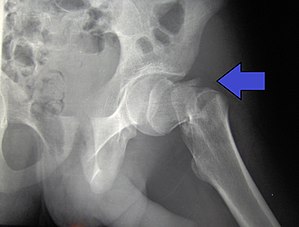Hip fractures
| Hip fracture | |
|---|---|
 |
|
| Intertrochanteric hip fracture in a 17-year-old male | |
| Classification and external resources | |
| ICD-10 | S72.0 |
| MeSH | 68006620 |
A hip fracture is a serious femoral fracture that occurs in the proximal end of the femur (the long bone running through the thigh), near the hip.
The term "hip fracture" is commonly used to refer to four different fracture patterns and is often due to osteoporosis; in the vast majority of cases, a hip fracture is a fragility fracture due to a fall or minor trauma in someone with weakened osteoporotic bone. Most hip fractures in people with normal bone are the result of high-energy trauma such as car accidents, falling from heights, or sports injuries.
In the UK, the mortality following a fractured neck of femur is between 30% within a year in people around age 80, of whom 80% were women.
The classic clinical presentation of a hip fracture is an elderly patient who sustained a low-energy fall and now has pain and is unable to bear weight. On examination, the affected extremity is often shortened and unnaturally, externally rotated compared to the unaffected leg.
Hip fracture following a fall is likely to be a pathological fracture. The most common causes of weakness in bone are:
The hip joint, an enarthrodial joint, can be described as a ball and socket joint. The femur connects at the acetabulum of the pelvis and projects laterally before angling medially and inferiorly to form the knee. Although this joint has three degrees of freedom, it is still stable due to the interaction of ligaments and cartilage. The labrum lines the circumference of the acetabulum to provide stability and shock absorption. Articular cartilage covers the concave area of acetabulum, providing more stability and shock absorption. Surrounding the entire joint itself is a capsule secured by the tendon of the psoas muscle and three ligaments. The iliofemoral, or Y, ligament is located anteriorly and serves to prevent hip hyperextension. The pubofemoral ligament is located anteriorly just underneath the iliofemoral ligament and serves primarily to resist abduction, extension, and some external rotation. Finally the ischiofemoral ligament on the posterior side of the capsule resists extension, adduction, and internal rotation. When considering the biomechanics of hip fractures, it is important to examine the mechanical loads the hip experiences during low energy falls.
...
Wikipedia
